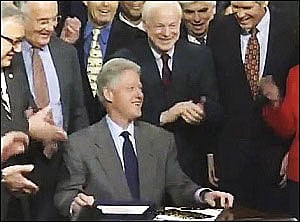57 Percent of Our Banks Have Disappeared: You Can Thank Bill Clinton

Featured image: President Bill Clinton Laughs It Up as He Signs the Repeal of the Glass-Steagall Act, November 12, 1999
Thanks to the Presidential debates, most Americans have heard of the Glass-Steagall Act which kept the country’s banking system safe for 66 years until it was repealed by President Bill Clinton in 1999, allowing the risky activities of Wall Street trading firms to merge with insured-deposit banks, setting the stage for the Wall Street collapse in 2008. But few Americans have ever heard of the Riegle-Neal Interstate Banking and Branching Efficiency Act of 1994, which Bill Clinton signed into law less than two years after taking office. The Riegle-Neal legislation allowed bank holding companies to acquire banks anywhere in the nation and invalidated the laws of 36 states which had allowed interstate banking only on a reciprocal or regional basis.
Put these two pieces of legislation together with the Commodity Futures Modernization Act of 2000, also signed into law by Bill Clinton, which allowed trillions of dollars of OTC derivatives on Wall Street to escape regulation, and you have just defined America’s current banking system from hell.
In 1934, there were 14,146 commercial banks with FDIC insurance in the United States. By 1985, that number had barely budged – we had a total of 14,417. But as of this month, we have 6,172 FDIC-insured commercial banks, a decline of 57 percent, with the annual declines accelerating after the passage of Riegle-Neal in 1994.
Making the banking system decidedly grim in terms of both competition and the potential for more taxpayer bailouts, of the current 6,172 banks holding a total of $15.9 trillion in assets, just four banks (JPMorgan Chase, Bank of America, Wells Fargo and Citibank, a unit of Citigroup, hold 41 percent of those assets – rendering them too-big-to-fail and an albatross around the neck of the country’s economic prospects and the taxpayers’ pocketbook. (All four of the banks took billions of dollars under the Troubled Assets Relief Program during the 2008-2010 financial crisis and Citigroup received the largest bank bailout in U.S. history: $45 billion in equity infusions, over $300 billion in asset guarantees, and more than $2 trillion in cumulative, below-market rate loans from the Federal Reserve — loans that were initially kept secret from the taxpayer.)
(…)

